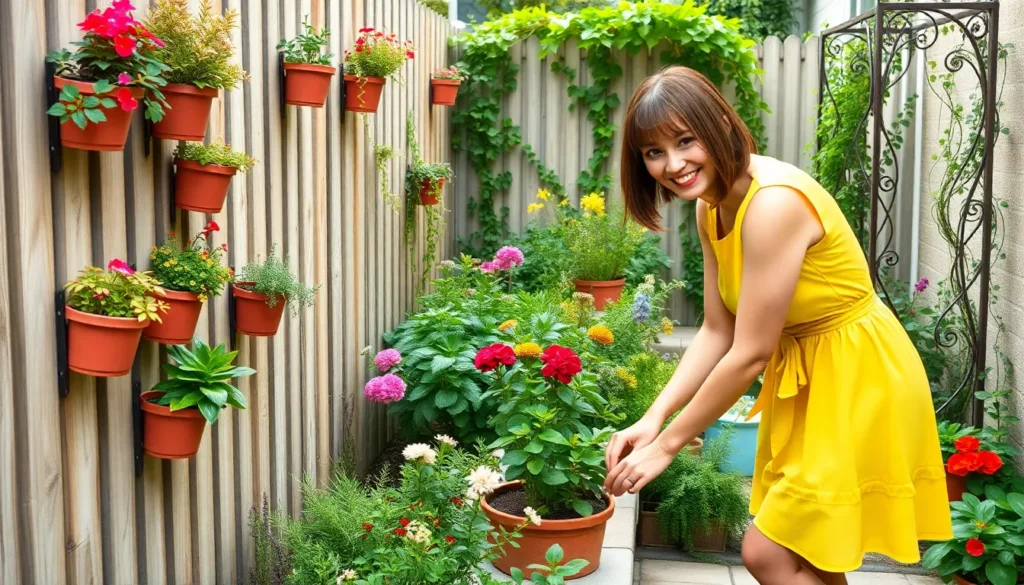Working with a narrow garden space doesn’t mean compromising on beauty or functionality. We’ve all faced the challenge of transforming those awkward strips of land alongside driveways, between houses, or tucked into tight corners. These seemingly impossible spaces actually offer incredible potential for creative landscaping answers.
We understand that narrow gardens present unique design challenges – from maximizing visual impact to ensuring proper plant spacing and creating depth. The key lies in embracing vertical growing techniques, selecting the right plants, and implementing smart design strategies that make your space feel larger than it actually is.
Whether you’re dealing with a slim side yard, a narrow front garden strip, or a tight urban space, we’ll share proven ideas that transform these challenging areas into stunning garden showcases. From dramatic vertical displays to clever illusion techniques, these narrow garden answers will help you create an outdoor space that’s both beautiful and practical.
Vertical Gardening Solutions for Maximum Space Utilization
Moving upward transforms narrow garden challenges into opportunities for creative growing. We’ll explore three proven vertical approaches that maximize every square inch of your slim outdoor space.
Living Walls and Green Screens
Living walls create instant privacy while adding lush greenery to narrow spaces. These vertical gardens work perfectly along fence lines or as room dividers between different garden zones. We recommend starting with modular pocket planters that attach directly to existing walls or fences.
Popular plant choices include:
- Succulents like hens and chicks or jade plants
- Herbs such as basil, thyme, and oregano
- Trailing varieties like pothos or sweet potato vine
- Ferns for shadier wall locations
Green screens offer flexible privacy answers that grow over time. Fast growing vines like morning glory or clematis create natural barriers within a single growing season. These living curtains filter harsh winds while softening hard surfaces in narrow garden areas.
Trellises and Climbing Structures
Trellises maximize vertical growing space while supporting heavy producing plants. We’ve found that sturdy metal or wooden frameworks handle the weight of tomatoes, cucumbers, and beans better than flimsy alternatives. Position trellises along the longest wall of your narrow garden for maximum sun exposure.
Essential climbing plant options include:
- Edible vines like pole beans, peas, and squash
- Flowering climbers such as sweet peas and nasturtiums
- Perennial options like grape vines or hardy kiwi
- Annual climbers including morning glories and moonflowers
Arched structures add height and visual interest to narrow pathways. These overhead frameworks support climbing roses or flowering vines while creating natural doorways between garden sections. We suggest placing arches at the entrance or midpoint of long narrow spaces.
Tiered Planting Systems
Tiered planters create multiple growing levels within minimal floor space. Staircase style arrangements work especially well against walls or fences in narrow gardens. Each level receives different amounts of sunlight, allowing us to grow various plant types in the same vertical footprint.
Effective tiered arrangements include:
| Level | Plant Type | Examples |
|---|---|---|
| Top tier | Sun loving herbs | Rosemary, lavender, sage |
| Middle tier | Compact vegetables | Cherry tomatoes, peppers |
| Bottom tier | Shade tolerant greens | Lettuce, spinach, kale |
| Ground level | Spreading plants | Strawberries, thyme |
Hanging planters add growing space without taking up ground area. We position these containers at varying heights to create visual depth in narrow garden designs. Trailing plants like petunias or cherry tomatoes work beautifully in suspended arrangements.
Ladder planters repurpose old wooden ladders into charming vertical gardens. Each rung holds small pots or planters, creating an instant tiered system. These portable structures move easily to follow sunlight patterns throughout your narrow garden space.
Strategic Plant Selection for Narrow Spaces
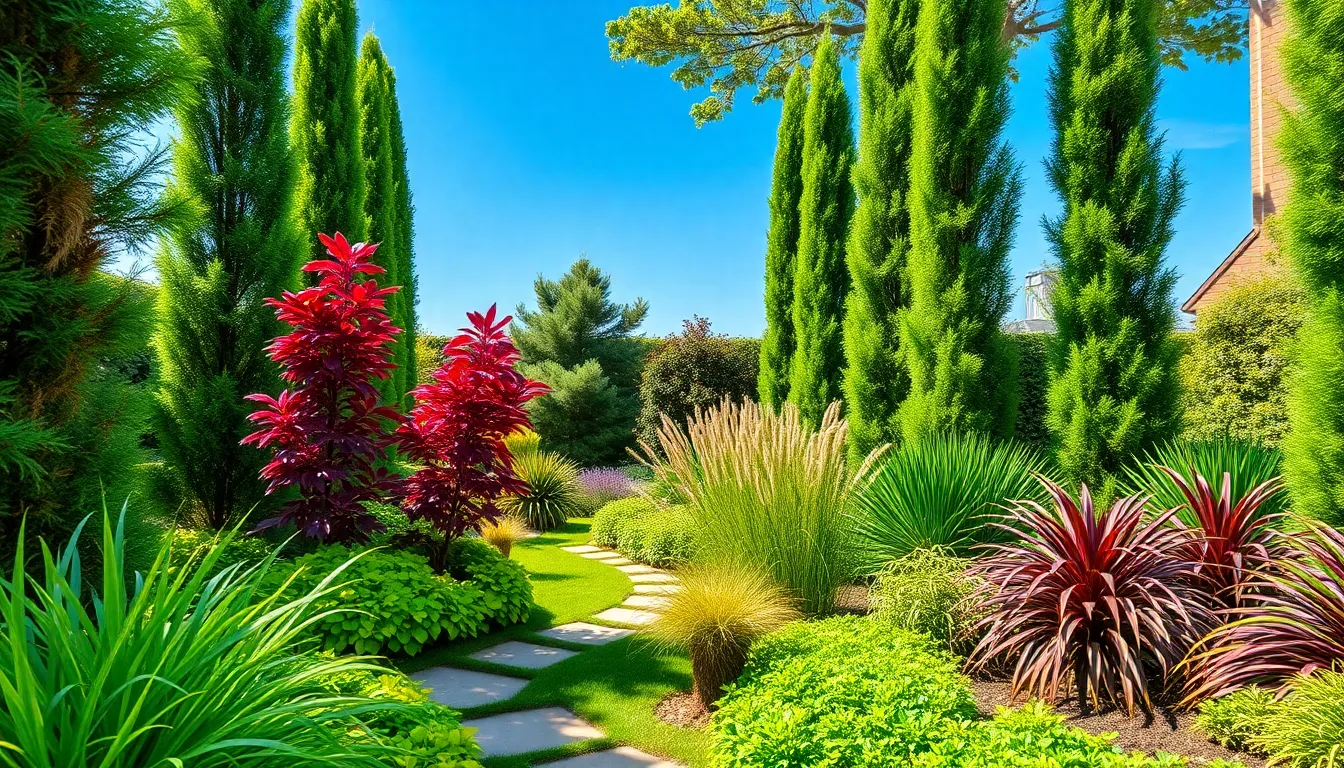
After establishing vertical growing systems, we need to focus on choosing the right plants that’ll thrive in confined areas. Smart plant selection makes the difference between a cramped garden and a stunning narrow space showcase.
Compact and Dwarf Varieties
Compact cultivars work perfectly in restricted planting zones without creating overcrowded conditions. We recommend dwarf Japanese maple (Acer palmatum) varieties that provide stunning foliage color while maintaining manageable proportions. Petite conifers add year-round structure and texture to narrow beds without overwhelming the available space.
Miniature roses deliver classic garden beauty in small packages, offering continuous blooms throughout the growing season. These varieties typically reach 12-24 inches in height, making them ideal for narrow border plantings. Dwarf shrubs like compact boxwood create formal structure while staying within their designated growing areas.
Container gardening with dwarf varieties gives us flexibility to rearrange our narrow garden layout as seasons change. We can easily move these plants to optimize sunlight exposure or create different visual arrangements throughout the year.
Multi-Seasonal Interest Plants
Year-round appeal becomes crucial in narrow spaces where every plant needs to earn its place. Evergreens like dwarf boxwood and holly (Ilex) provide consistent structural elements that anchor our garden design through all seasons. These plants maintain their visual impact when deciduous varieties go dormant.
Ornamental grasses add movement and texture while requiring minimal maintenance throughout the year. We particularly recommend Karl Foerster feather reed grass (Calamagrostis x acutiflora) for its upright growth habit and golden fall color. Perennials such as heuchera offer colorful foliage from spring through frost, while sedum provides late season blooms and winter interest.
Strategic layering of multi-seasonal plants ensures our narrow garden never looks empty or unfinished. We combine evergreen structure plants with seasonal color providers to create ever-changing visual interest that changes throughout the year.
Narrow-Growing Tree Options
Vertical accent trees help frame narrow gardens while drawing the eye upward to create an illusion of expanded space. Columnar trees like fastigiate hornbeam (Carpinus betulus ‘Fastigiata’) provide height without excessive width, making them perfect for restricted planting areas. These naturally narrow specimens typically grow 30-40 feet tall but only 10-15 feet wide.
Skyrocket juniper (Juniperus scopulorum ‘Skyrocket’) offers dramatic vertical impact with its pencil-thin profile and blue-green foliage. We often use these specimens as living fence posts or to create privacy screens along property lines. Their mature width rarely exceeds 3-4 feet, making them ideal for the tightest spaces.
Selecting trees with naturally upright habits eliminates the need for constant pruning to maintain size. We can achieve important height and visual drama without sacrificing precious ground space for wider-spreading varieties.
| Plant Category | Example Species | Mature Size | Key Benefits |
|---|---|---|---|
| Compact Shrubs | Dwarf Japanese maple | 4-8 feet | Seasonal color, manageable size |
| Evergreen Structure | Dwarf boxwood | 2-4 feet | Year-round interest, formal appeal |
| Ornamental Grasses | Karl Foerster feather reed | 3-5 feet | Movement, low maintenance |
| Columnar Trees | Fastigiate hornbeam | 30-40 feet tall, 10-15 feet wide | Vertical accent, space efficiency |
| Narrow Conifers | Skyrocket juniper | 15-20 feet tall, 3-4 feet wide | Privacy, dramatic profile |
Creative Container Gardening Approaches

Container gardening transforms narrow spaces by offering flexible answers that maximize every square inch. We can create ever-changing displays that add both function and style to our compact outdoor areas.
Wall-Mounted Planters
Wall-mounted planters enable vertical gardening while freeing up valuable ground space in our narrow gardens. We can arrange these planters in modular units or custom-built shelves to create living backdrops that soften hard surfaces and add privacy. These systems work exceptionally well for growing herbs, succulents, and flowering plants that thrive in contained environments.
Strategic placement of wall planters creates color and texture against otherwise bare walls. We’ll find that mounting planters at varying heights adds visual interest and draws the eye upward, making our narrow space feel more expansive. The modular nature of these systems allows us to customize arrangements based on our exact plants’ needs and our garden’s aesthetic goals.
Hanging Basket Arrangements
Hanging baskets use overhead space effectively, making them perfect for narrow gardens with restricted floor area. We can create visual layers by positioning baskets at different heights, which adds depth and makes our garden feel larger than its actual dimensions. These versatile containers work beautifully for trailing plants, ferns, and seasonal flowers that cascade downward.
Different materials and sizes of hanging baskets allow us to customize our displays throughout the growing season. We can easily swap out seasonal arrangements or relocate baskets to optimize sunlight exposure. The overhead positioning of hanging baskets draws the eye upward, creating the illusion of expanded vertical space in our narrow garden areas.
Stackable Container Systems
Stackable containers provide a compact way to grow various plants in a minimal footprint while maximizing our growing space vertically. We can create tiered arrangements that allow for multiple plant layers without spreading horizontally across our limited ground area. These systems prove especially useful for cultivating vegetables, herbs, or ornamental plants in organized, accessible arrangements.
The movable nature of stackable containers lets us rearrange our garden layout as needed throughout the growing season. We can easily relocate entire sections to optimize sunlight exposure or create new visual arrangements. This flexibility makes stackable systems ideal for experimenting with different plant combinations and seasonal displays in our narrow garden spaces.
Optical Illusion Techniques to Expand Visual Space
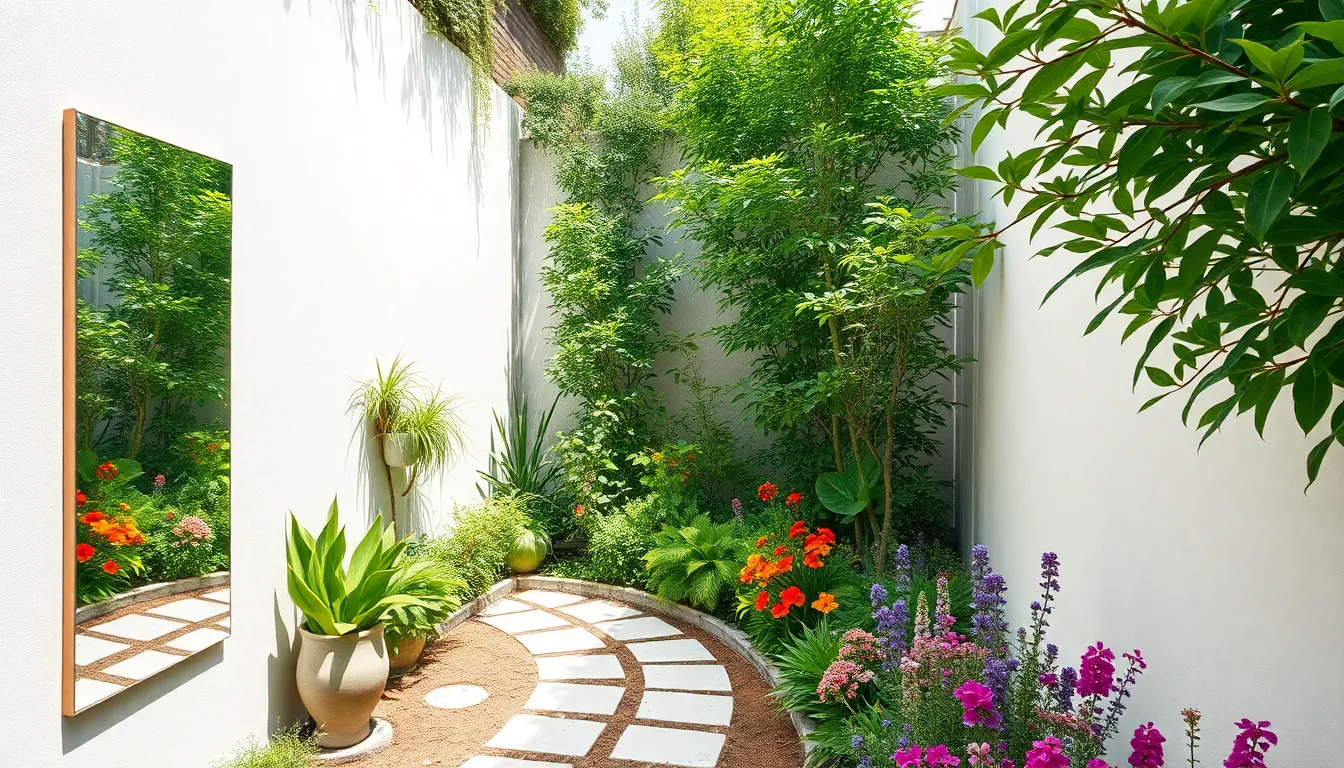
Creating the perception of spaciousness in narrow gardens requires clever visual tricks that fool the eye. We’ll explore proven techniques that make tight spaces feel dramatically larger through strategic design choices.
Mirror Placement Strategies
Corner mirrors transform narrow spaces by reflecting surrounding elements and creating infinite depth. Position large mirrors at 45-degree angles in garden corners to capture maximum light and greenery reflection. Wall mirrors mounted on fences or boundary walls double the visual impact of adjacent plants and decorative features.
Strategic placement amplifies natural light throughout the day. Install weatherproof mirrors opposite windows or bright areas to bounce illumination into shadowy corners. Tilt mirrors slightly downward to reflect colorful flower beds and ground-level plantings rather than sky or neighboring structures.
Frame selection enhances the illusion’s effectiveness. Choose mirrors with thin, dark frames that blend into backgrounds or opt for frameless designs that disappear completely. Antique-style mirrors add character while maintaining the space-expanding effect in traditional garden settings.
Light-Colored Hardscaping Elements
Pale pavers and light-colored gravel immediately brighten narrow pathways and planting areas. Select cream, white, or soft gray materials that reflect sunlight upward to surrounding plants and structures. Light-colored decomposed granite creates cohesive ground cover that visually expands the entire garden footprint.
White and cream-painted walls maximize light reflection throughout confined spaces. Paint existing fences, retaining walls, and garden structures in soft, neutral tones to create an airy atmosphere. Light-colored paint also serves as an excellent backdrop for dark green foliage and colorful blooms.
Reflective hardscaping materials multiply available light in shaded narrow areas. Choose polished concrete, light-colored stone, or pale brick for permanent installations. These surfaces bounce natural light between walls and create the impression of wider, more open garden rooms.
Diagonal Pathway Designs
Diagonal walkways create ever-changing sight lines that make narrow gardens appear longer and wider. Install pathways that cut across the space at 30 to 45-degree angles rather than running straight along the length. This technique draws the eye across the garden’s width and creates visual interest through unexpected geometry.
Winding curved paths encourage slower exploration and create multiple garden “rooms” within tight spaces. Design serpentine walkways that curve around planted areas and architectural features. Each curve reveals new views and makes the journey through the garden feel longer than the actual distance.
Stepping stone patterns arranged diagonally break up linear sight lines effectively. Space individual pavers or stones in zigzag formations that guide visitors across planted beds. This approach softens hard edges while maintaining functionality and adding visual texture to narrow garden floors.
Multi-Functional Garden Features for Narrow Areas
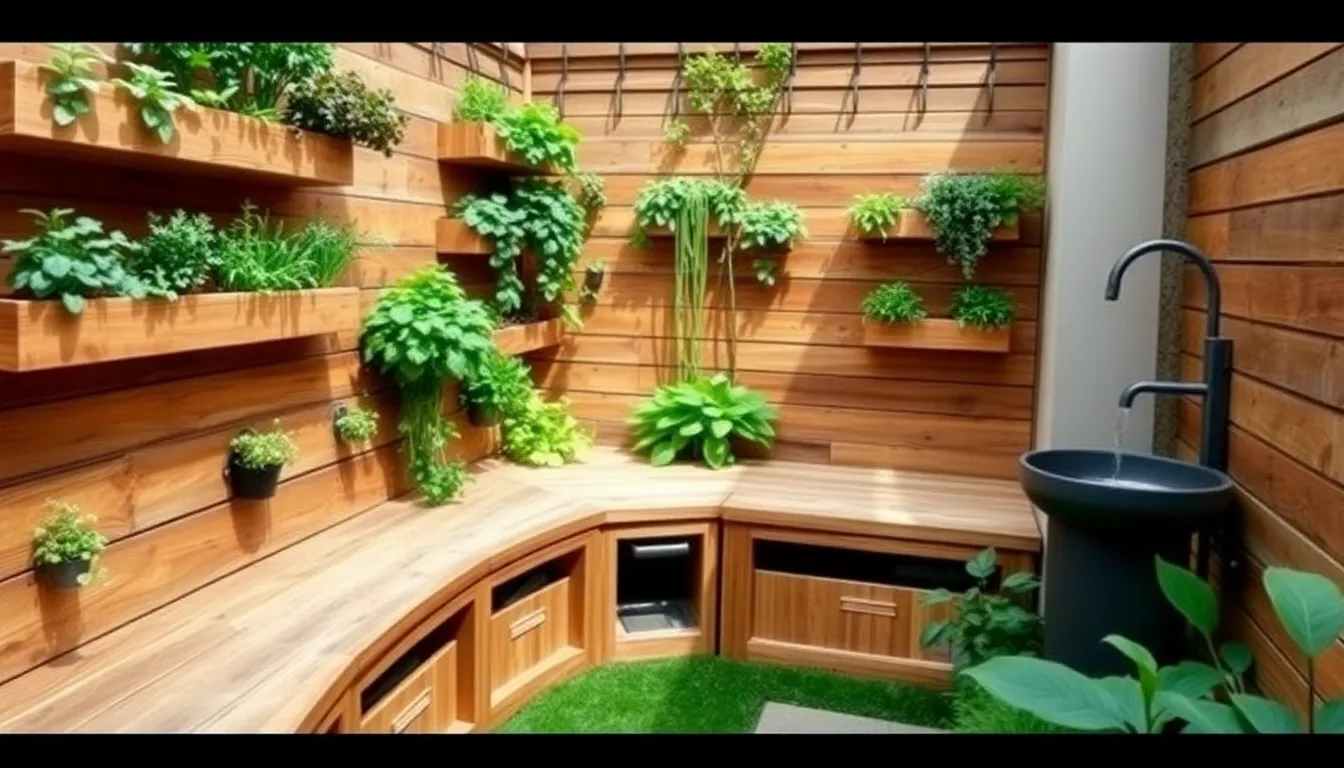
Smart design answers maximize every square foot when space is at a premium. These versatile features serve multiple purposes while maintaining the beauty and functionality of your narrow garden.
Built-In Seating with Storage
Creating dual-purpose seating transforms cramped gardens into organized outdoor living spaces. We recommend installing benches with hinged tops that reveal hidden compartments underneath. Garden tools, cushions, and seasonal decorations stay protected while remaining easily accessible.
Positioning built-in seating along perimeter walls maximizes your narrow garden’s usable area. Corner benches work particularly well because they use awkward spaces that might otherwise remain empty. The storage capacity ranges from 2-4 cubic feet depending on the bench size.
Materials like cedar or composite decking ensure your seating withstands weather while maintaining an attractive appearance. We suggest adding weather-resistant hinges and drainage holes to prevent moisture buildup inside storage compartments.
Combination Herb and Vegetable Gardens
Vertical planters revolutionize how we grow edibles in tight spaces. Tiered systems allow you to cultivate basil, tomatoes, lettuce, and peppers in the same footprint as a single traditional planter. These arrangements can produce 3-5 times more food per square foot than conventional gardening methods.
Implementing companion planting strategies maximizes harvest yields while saving precious space. We pair herbs like oregano with tomatoes, or plant lettuce beneath taller vegetables to create natural shade. This approach increases productivity by 25-40% in narrow garden areas.
Modular growing systems offer flexibility for seasonal changes and crop rotation. Wall-mounted planters can be rearranged based on sunlight patterns or plant growth requirements throughout the growing season.
Water Features That Save Space
Wall-mounted fountains provide soothing sounds without consuming valuable floor space. These features typically require only 6-12 inches of wall depth while creating dramatic focal points. We recommend models with recirculating pumps that use minimal water and electricity.
Narrow shallow ponds fit perfectly along garden borders or walkway edges. Linear water features measuring 2-3 feet wide can accommodate small aquatic plants and create reflection points that visually expand your space. The depth ranges from 8-18 inches, making maintenance simple.
Installing bubble fountains or water walls adds vertical interest while maintaining safety. These compact features work well in gardens frequented by children or pets since they eliminate standing water concerns while providing the calming effects of moving water.
Lighting Solutions to Enhance Narrow Garden Appeal
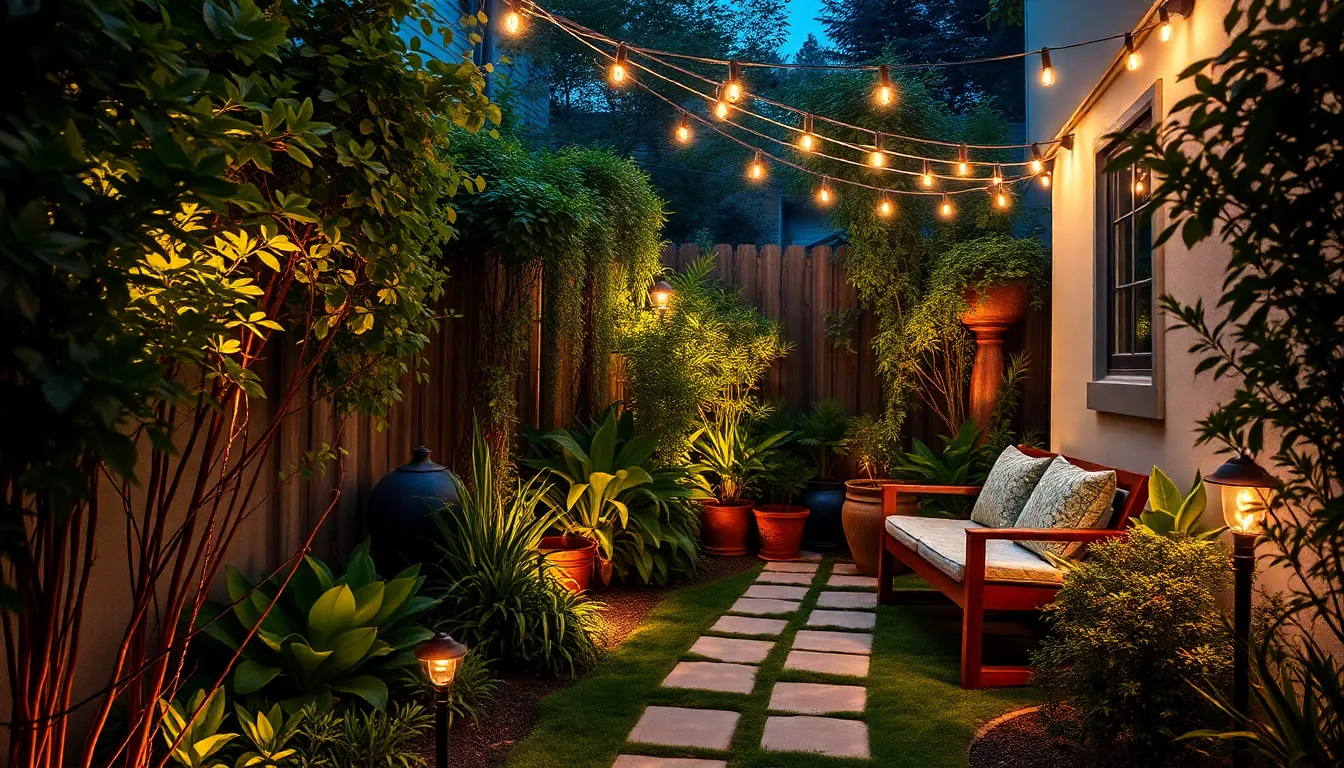
Proper lighting transforms narrow gardens from overlooked spaces into enchanting outdoor retreats. Strategic illumination creates depth and visual interest while extending the usability of these compact areas well into the evening hours.
Solar Pathway Illumination
Solar pathway lights offer the perfect solution for narrow garden spaces without the complexity of electrical installations. We recommend placing these eco-friendly fixtures along walkways to create warm, inviting ambiance that guides visitors through your compact outdoor space. Installation requires no wiring, making them ideal for renters or DIY enthusiasts who want immediate results.
These energy-efficient lights automatically charge during daylight hours and illuminate pathways throughout the night. Spacing them 6-8 feet apart ensures even coverage while preventing the narrow area from appearing cluttered. Modern solar pathway lights deliver reliable performance for up to 8 hours on a full charge, providing consistent illumination for evening garden enjoyment.
String Light Installations
String lights bring festive charm to narrow gardens while maximizing vertical space usage. We suggest wrapping these versatile fixtures around existing plants, trellises, or overhead structures to create cozy atmospheric lighting. Budget-friendly bistro lights can instantly transform cramped spaces into intimate outdoor dining areas or relaxation zones.
Installation options include permanent mounting systems or temporary seasonal displays that adapt to changing garden layouts. Warm white LED string lights consume minimal energy while providing soft, flattering illumination that enhances plant textures and architectural features. Dimmer controls allow you to adjust brightness levels for different occasions, from quiet evening reading to entertaining guests.
Uplighting for Vertical Elements
Uplighting creates dramatic visual impact by highlighting tall plants, walls, and vertical garden features in narrow spaces. We position ground-level spotlights to cast upward beams that emphasize architectural elements and create depth perception in confined areas. This technique draws the eye upward, making narrow gardens appear more spacious and visually interesting.
Strategic placement of LED uplights beneath specimen plants or along fence lines adds dimension to flat surfaces while showcasing your garden’s vertical elements. Adjustable fixtures allow you to modify beam angles seasonally as plants grow and change. Low-voltage options ensure safety while delivering professional-quality results that rival expensive industry lighting systems.
Layout Design Principles for Long, Thin Spaces
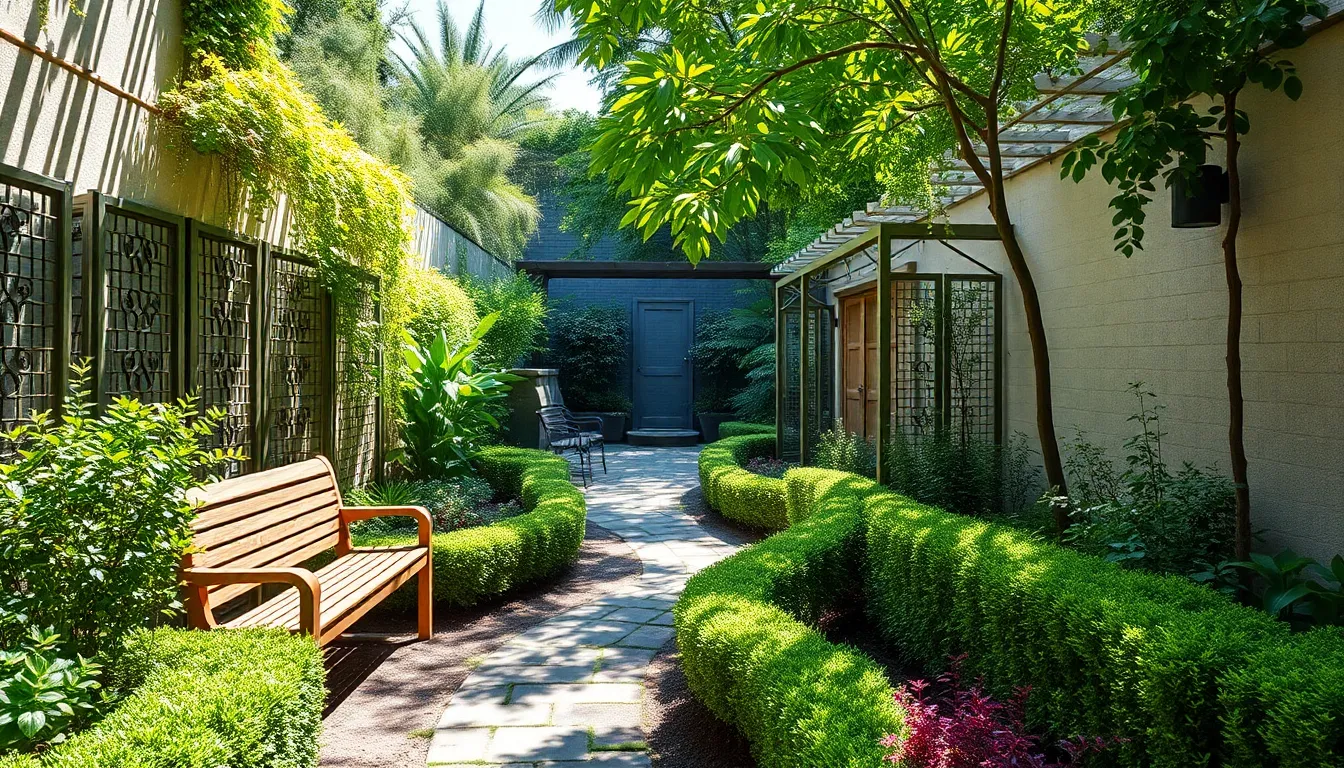
Transform your narrow garden’s challenging proportions into stunning outdoor rooms with strategic layout techniques. We’ll show you how to create visual depth and maximize usability in long, thin spaces.
Room Division Techniques
Create visual rooms without blocking the view by using low hedges that maintain sight lines throughout your narrow garden. Open trellises work exceptionally well for dividing spaces while preserving the feeling of openness that’s crucial in confined areas.
Maintain visibility across sections using partial barriers like decorative screens or planted borders that suggest separation without creating walls. These subtle divisions help break up the linear feel of narrow spaces while keeping the area from feeling cramped.
Focus on people spaces first, then plants to ensure your narrow garden serves its primary function as a usable outdoor area. This prioritization approach maximizes functionality while maintaining aesthetic appeal in limited square footage.
Focal Point Creation Methods
Place seating areas strategically to create natural stopping points that draw attention away from the garden’s narrow proportions. Benches positioned at key intervals serve as both functional elements and visual anchors.
Install pergolas at mid points to add vertical interest and create intimate spaces within the longer garden layout. These structures break up sight lines and provide natural gathering spots.
Add water features or statues that create depth and visual interest while serving as destination points along your narrow garden’s length. Small fountains or sculptural elements work particularly well in creating focal moments.
Position interest points deliberately to encourage visitors to pause and appreciate different garden sections rather than simply walking straight through the space.
Flow and Movement Optimization
Design curved paths to slow down movement and distract from the garden’s linear dimensions. Winding walkways create a sense of discovery and make the space feel larger than its actual measurements.
Block direct views to the garden’s end using strategic plantings or decorative elements that create curiosity and encourage exploration. This technique prevents the eye from immediately grasping the full length of the space.
Create punctuation points along pathways where visitors naturally want to stop and observe their surroundings. These pause areas make the journey through your narrow garden more captivating and memorable.
Use off center paths to disguise the garden’s narrowness and create a more ever-changing walking experience. This approach makes the space feel wider while adding visual interest to the overall design.
Low-Maintenance Ideas for Busy Narrow Garden Owners

Creating beautiful narrow gardens doesn’t require constant upkeep when we choose the right strategies. Smart plant selections and automated systems can transform your thin outdoor space into a thriving sanctuary that practically takes care of itself.
Drought-Tolerant Plant Combinations
Lavender and succulents create stunning pairings that thrive together in well-draining soil conditions. These powerhouse plants require minimal watering once established and provide year-round visual interest with their contrasting textures and colors.
Hardy geraniums paired with Erigeron karvinskianus deliver extended flowering seasons that last from spring through fall. Both species tolerate dry conditions exceptionally well and need minimal watering intervention throughout the growing season.
Mediterranean herb gardens featuring rosemary, thyme, and oregano offer practical beauty while requiring virtually no supplemental irrigation. These aromatic plants actually prefer slightly dry conditions and reward neglect with stronger flavors and more robust growth.
Ornamental grass clusters like fountain grass or blue fescue create dramatic focal points in narrow spaces. They establish deep root systems that access moisture far below surface level, making them perfect for busy gardeners who travel frequently.
Automated Irrigation Systems
Smart watering systems automatically adjust their schedules based on real-time weather conditions, ensuring your narrow garden receives optimal moisture without waste. These intelligent controllers connect to local weather stations and skip watering cycles during rainy periods.
Drip irrigation networks deliver water directly to plant root zones through strategic tubing placement along your narrow garden beds. This targeted approach reduces water consumption by up to 50% compared to traditional sprinkler methods while preventing leaf diseases.
Micro-spray systems provide gentle, consistent moisture coverage for densely planted narrow areas without creating runoff or erosion. These low-pressure systems work exceptionally well for container gardens and raised bed installations.
Timer-controlled soaker hoses offer budget-friendly automation that slowly releases water at soil level throughout your narrow garden beds. We can set these systems to operate during early morning hours when evaporation rates remain lowest.
Mulching and Ground Cover Answers
Organic mulching using wood chips or bark reduces soil moisture loss significantly while suppressing weed growth naturally. This protective layer moderates soil temperature fluctuations and gradually improves soil structure as it decomposes.
Creeping thyme carpets create fragrant, walkable ground cover that requires minimal maintenance once established. This hardy perennial releases pleasant aromatics when stepped on and produces tiny flowers that attract beneficial pollinators.
Vinca minor (Periwinkle) spreads reliably in shaded narrow areas where grass struggles to grow. These evergreen ground covers produce delicate blue or white flowers in spring and maintain attractive foliage throughout winter months.
Living mulch combinations featuring low-growing sedums and moss create attractive alternatives to traditional organic mulches. These plant-based answers eliminate the need for annual mulch replacement while providing continuous soil protection and visual appeal.
Conclusion
We’ve shown that narrow gardens aren’t limitations – they’re opportunities for creative design that can rival any expansive industry. With vertical growing techniques container systems and strategic plant selection you can transform even the slimmest outdoor space into a stunning garden retreat.
The key lies in thinking beyond traditional gardening approaches. By combining optical illusions with multi-functional features and low-maintenance answers we create gardens that feel spacious functional and beautiful year-round.
Your narrow garden journey starts with choosing the techniques that best suit your space and lifestyle. Whether you’re drawn to living walls drought-tolerant plantings or automated irrigation systems the possibilities are endless when you embrace vertical thinking and smart design principles.
Frequently Asked Questions
What are the best plants for narrow garden spaces?
Choose compact and dwarf varieties like dwarf Japanese maples, miniature roses, and columnar trees such as skyrocket junipers. Multi-seasonal plants like evergreens and ornamental grasses provide year-round appeal. Mediterranean herbs, succulents, and drought-tolerant plants are excellent for low-maintenance narrow gardens while maximizing space efficiency.
How can I make my narrow garden look bigger?
Use optical illusion techniques like placing mirrors in corners to reflect light and greenery. Install light-colored hardscaping elements such as pale pavers and painted walls. Create diagonal or curved pathways with stepping stones to add visual interest and make the space appear wider than it actually is.
What vertical gardening solutions work best for tight spaces?
Implement living walls with succulents and herbs, install trellises for climbing plants, and use tiered planting systems. Wall-mounted planters, hanging baskets, and stackable container systems maximize vertical space. These solutions allow you to grow more plants without using valuable ground space in narrow areas.
How do I create privacy in a narrow garden?
Use fast-growing vines on trellises, install living walls or green screens, and plant narrow-growing trees like columnar varieties. Low hedges and partial barriers can divide spaces while maintaining sight lines. Wall-mounted planters and climbing structures also provide natural screening without taking up floor space.
What are some low-maintenance options for narrow gardens?
Choose drought-tolerant plant combinations like lavender with succulents, or hardy geraniums with ornamental grasses. Install automated drip irrigation systems for efficient watering. Use organic mulches and low-growing ground covers like creeping thyme to retain moisture and reduce weeding needs while maintaining visual appeal.
How can I add functionality to my narrow garden space?
Incorporate multi-functional features like built-in seating with storage compartments. Create combination herb and vegetable gardens using vertical planters. Install space-saving water features such as wall-mounted fountains. These elements maximize every square foot while providing practical benefits for outdoor living and gardening.
What layout principles work best for long, thin gardens?
Break up linear spaces using room division techniques with low hedges or partial barriers. Create multiple focal points like seating areas, pergolas, or water features at different intervals. Design curved or off-center pathways to enhance flow and movement, making the narrow space feel more dynamic and inviting.
How do I choose containers for narrow space gardening?
Select wall-mounted planters for vertical growing, hanging baskets to utilize overhead space, and stackable container systems for flexibility. Choose containers that complement your garden’s style while maximizing growing space. Ensure proper drainage and consider the mature size of plants when selecting container dimensions for optimal growth.

